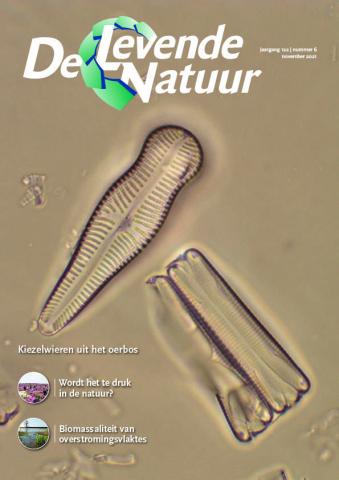De Levende Natuur nummer 6 van 2021 (English summary)
Afbeelding

Biodiversity in dune grasslands: P availability and plant strategies
Annemieke Kooijman, Bas Arens, Job van de Voort, Jaap Bloem & Mark van Til
Lime-rich and lime-poor Grey dunes (H2130) differ in soil P availability and consequently in plant strategies for P uptake. This affects many ecosystem properties and may lead to different stable states. In lime-rich dune soils, mineral P may be abundant, but unavailable to the vegetation at high pH. Therefore, lime-rich Grey dunes are dominated by arbuscular mycorrhizal (AM) plants, which improve P uptake with help of AM-fungi. These plants profit especially when P is a growth-limiting factor. However, photosynthesis costs of sugar supply to the fungi may lead to reduced growth rates, low plant biomass and high species diversity even under unfavourable conditions of high atmospheric N deposition. In lime-poor dunes, in contrast, availability of P to the vegetation is higher due to dissolution of calcium phosphates and weaker P sorption at low pH. The vegetation is dominated by nonmycorrhizal (NM) plants, which take up weakly bound P. High P availability leads to high plant biomass and grass-encroachment, especially when N deposition is also high. Thus, dominance of AMor NM-plants in different dune zones may lead to changes in the soil community, but also to differences in food quality of aboveground vegetation and in root biomass, which may in turn affect rabbit density and blowout activity, and reinforce patterns in pH, P availability to the vegetation, plant uptake strategies and plant diversity.
Diatoms on old (1834-1854) herbarium material from the former Beekbergerwoud
Herman van Dam & Adrienne Mertens
The Beekbergen alder forest was cut down in the years 1869-1871 and transformed to agricultural grassland.
In Naturalis Biodiversity Center, herbarium material from aquatic and marsh plants (including mosses) from the years 1834-1854 was traced. Small pieces of plants were used to make prepared microscopic slides of the attached diatoms. The species composition was determined semi-quantitatively. 107 taxa were found, of which 28 are rare for the Netherlands. These are mainly taxa from clean, (weakly) buffered waters, which often have a main distribution in low mountain ranges, the Alps or Scandinavia. Five new taxa were found for the Netherlands. These too are mainly taxa of clean waters.
There are samples with many and few flow indicators and there are differences in the presence of drought indicators. The acidity indications indicate predominantly neutral to alkaline conditions, but locally there would have been slightly acidic conditions as well. This corresponds with the variations in quality of upwelling groundwater. The tropic state was in the meso- to eutrophic range. The variation in saprobity indications is probably related to differences in the presence of digestive tree leaf.
In the last decades, parts of the former Beekbergerwoud were acquired by a nature conservancy organization. As there is still a strong influx of clean, alkaline groundwater, a partial comeback of the former rich diatom flora might be possible, when proper restoration measures are taken.
Opportunities for ecological recovery of spring inundated river floodplains
Marijn Nijssen, Gijs Kurstjens, Henk Moller Pillot, Martijn Dorenbosch, Chris van Turnhout & Alphons van Winden
Temporal inundated floodplains are almost absent in human-influenced rivers but are important ecological elements in natural river systems, given their high diversity and productivity. In this study, restoration chances of temporal floodplains in the Netherlands are analysed. To function as a habitat for typical species and to create the opportunity for development of a rich food web, the following factors should occur: 1) a sufficient long period of inundation (minimum of eight weeks, preferably longer) starting at early March to ensure a sufficient high water temperature and light availability; 2) connectivity with permanent waters and with non-inundated areas; 3) gradients in both meso-relief, substrate and vegetation structure; 4) a sufficient large area (i.e., 20-25 ha within a floodplain with a minimum area of 100 ha). Based on a GIS analysis, four areas along the rivers Rhine and IJssel are selected as promising for restoration of temporal inundated floodplains.
Effect of retaining water on fish in the inundated floodplain Buiten Ooij
Martijn Dorenbosch & Margriet Schoor
Natural temporarily inundated floodplains are characterized by a fish community with a high diversity and productivity. It is unknown whether the present Dutch human-induced temporarily inundated floodplains are also relevant for fish. In this study, the fish community is analysed for the period 2018-2020 in the temporarily inundated floodplain ‘Buiten Ooij’. In Buiten Ooij, river water in the floodplain is contained after inundation by closing a locking mechanism in the summer dike.
Results of the survey show both high (juvenile) fish densities and species richness in the floodplain compared to other rivierhabitats. The waterbodies in Buiten Ooij are dominated by fish species associated with macrophytes such and European bitterling, rudd and sunbleak. Within the floodplain, some waterbodies fall completely dry during summer (killing all remaining fish), whereas other waterbodies greatly decrease in size but retain water (ensuring survival of fish). This mechanism greatly influences the fish community that may develop in temporarily inundated floodplains. It is also shown that the measurement in which water is artificially contained in the floodplain by closing a lock after a period of inundation, results in both higher water levels and fish densities in the subsequent spring and summer. Measurements that are aimed to increase and extend the flooding duration in a floodplain such as water containment by a lock mechanism, will have positive effects on fish communities in this river system.

